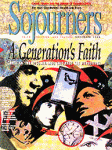Back in the late 1980s, I thought I was the ultimate twentysomething. Not because I fit a certain type—liberal activist or young Republican or slacker—but because I was connected to different factions simultaneously.
Sure, I was—am—a (democratic) socialist at heart, but some of my best friends are the guys I grew up with, most of whom are conservative, or at least apolitical. I could change stripes at will, transversing what I thought was the Gen X universe in the same night: from the nightclubs in downtown Washington, D.C., (with their self-conscious, politically astute but humorless clientele) to a beer bash in the ’burbs (with the brash and very funny—in a Howard Stern-esque kind of way) boys from prep school.
However, when the ’80s became the ’90s and Gen X got more and more media attention, I began to have doubts about my stature as the baby-buster representative. It seemed that Generation X wasn’t anything more than a cloud of smoke generated by trend-chasing magazine editors and the corporate hype machine hungry to hook young consumers.
Upon reflection I realized that I wasn’t a spokesperson for my peers as much as a member of two tribes that were isolated from each other—and from other groups, like inner-city hip-hoppers, gay acti-vists, and Latinos. The alienation being peddled as post-boom angst wasn’t generational, but a more general societal malaise that was reflected in the country’s young. As twentysomething Alexander Star wrote in "The Twentysomething Myth," an article in The New Republic: "As young people acquire adult responsibilities (and adult vices) at an earlier age, their distinctness as a group diminishes. They do not stamp a unique sensibility on society as much as mirror its disarray."
In Late Bloomers: The Declining Prospects of the Twentysomething Generation, a volume so slim it’s really just an essay, Alexander Abrams and David Lipsky further deconstruct the twentysomething myth—sort of. Using research and a sharp sense of economics and its role in creating sociological phenomenon, the authors believe that a Gen X collective consciousness does exist, but set out to prove that it owes its existence more to economics than culture.
THE CENTRAL argument of Late Bloomers is deceptively simple: Money is the tail that has wagged the twentysomething dog. In the 1980s when the economy was robust—albeit with a strength fueled by debt—the media were obsessed with the "materialism" and careerism of twentysomethings, making it sound like we’d run over our own grandmothers to make a buck.
When a recession hit in the summer of 1990, the young were the hardest hit. A million twentysomethings lost their jobs from May 1990 to May 1991, and overnight we went from greedy careerists to apathetic slackers in the eyes of the media. "It was easier to believe that if young adults weren’t working, it was because they no longer wanted to work," Lipsky and Abrams write. "To believe that the economy had shifted in such a way as to make employment very hard to come by for anyone just out of college was dispiriting, and would have required a very different set of responses by the country."
When they draw such a conclusion, Lipsky and Abrams are close to making a brilliant point—namely, that the inequalities of the free market deleteriously affect millions of lives, and that the Gen X’s disenfranchisement is merely a small dose—we’re talking homeopathic levels here—of the brutal economic mariginalization that has been endured by members of minority groups for centuries. Unfortunately, the authors don’t make the leap, restricting themselves to how the limp dollar justifies constant griping about the misery of having to take crummy jobs and live at home.
Still, while Late Bloomers shows up Generation X as an economic and media creation, the particular tribe that is the book’s target audience—namely, disgruntled young white middle-class kids—isn’t denied its existence. It’s been around at least since The Catcher in the Rye, and is still a rich source for artistic expression.
My current favorite example of this archetype is the comic book Hate. Hate stars Buddy Bradley, an intelligent, cynical, aimless twentysomething who drinks too much, can’t hold a job, and is constantly under siege by his dysfunctional family and neurotic friends.
Buddy’s scrapes ring frighteningly true to life—the one where he has to walk home from a party, finds himself locked out of his house, and passes out in the back seat of his dad’s car is priceless—and creator Peter Bagge’s art is some of the finest in the field. Bagge depicts his character’s emotions with wild exaggeration—eyes become hypnotic swirls or pop out of their sockets with shock, teeth grow razor sharp with anger—and the results are howlingly funny. And there is real poignancy in his writing, which isn’t so much politically incorrect as unsparing in depicting people the way they actually are.
Come to think of it, Hate goes be-yond the narrow parameters I set for it. Though the media still call it the apotheosis of twentysomething culture, its central theme is rather universal—alienation, that age-old American staple that has no respect for age.
Mark Gauvreau Judge is a free-lance writer and full-time slacker from Potomac, Maryland.

Got something to say about what you're reading? We value your feedback!